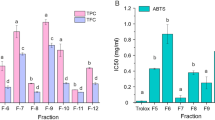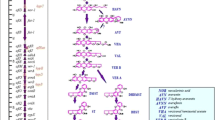Abstract
Aspergillus flavus is a ubiquitous saprophyte that is able to produce the most potent natural carcinogenic compound known as aflatoxin B1 (AFB1). This toxin frequently contaminates crops including corn, cotton, peanuts, and tree nuts causing substantial economic loss worldwide. Consequently, more than 100 countries have strict regulations limiting AFB1 in foodstuffs and feedstuffs. Plants and microbes are able to produce volatile compounds that act as a defense mechanism against other organisms. Pichia anomala strain WRL-076 is a biocontrol yeast currently being tested to reduce AF contamination of tree nuts in California. We used the SPME-GC/MS analysis and identified the major volatile compound produced by this strain to be 2-phenylethanol (2-PE). It inhibited spore germination and AF production of A. flavus. Inhibition of AF formation by 2-PE was correlated with significant down regulation of clustering AF biosynthesis genes as evidenced by several to greater than 10,000-fold decrease in gene expression. In a time-course analysis we found that 2-PE also altered the expression patterns of chromatin modifying genes, MYST1, MYST2, MYST3, gcn5, hdaA and rpdA. The biocontrol capacity of P. anomala can be attributed to the production of 2-PE, which affects spore germination, growth, toxin production, and gene expression in A. flavus.





Similar content being viewed by others
References
Amaikel S, Keller NP (2011) Aspergillus flavus. Annu Rev Phytopathol 49:107–133
Azziz-Baumgartner E, Lindblade K, Gieseker K, Rogers HS, Kieszak S, Njapau H, Schleicher R, McCoy LF, Misore A, DeCock K (2005) Case–control study of an acute aflatoxicosis outbreak, Kenya, 2004. Environ Health Perspect 113:1779–1783
Cary JW, Ehrlich KC, Bland, Montabano BG (2006) The aflatoxin biosynthesis cluster gene, aflX, encodes an oxidoreductase involved in conversion of versicolorin A to dimethylsterigmatocyctin. Appl Environ Microbiol 72:1096–1101
Cleveland TE, Carter-Wientjes CH, De Lucca AJ, Boue SM (2009) Effect of soybean volatile compounds on Aspergillus flavus growth and aflatoxin production. J Food Sci 74(2):H83–H87
Diener UL, Cole RJ, Sanders TH, Payne GA, Lee LS, Klich MA (1987) Epidemiology of aflatoxin formation by Aspergillus-Flavus. Annu Rev Phytopathol 25:249–270
Ehrlich KC, Yu J, Cotty PJ (2005) Aflatoxin biosynthesis gene clusters and flanking regions. J Appl Microbiol 99:518–527
Henry SH, Bosch FX, Bowers JC (2002) Aflatoxin, hepatitis and worldwide liver cancer risks. Adv Exp Med Biol 504:229–233
Horn BW (2005) Colonization of wounded peanut seeds by soil fungi: selectivity for species from Aspergillus section Flavi. Mycologia 97:202–217
Hua SST (2006) Progress in prevention of aflatoxin contamination in food by preharvest application of Pichia anomala WRL-076. In: Mendez-Vilas A (ed) Recent advances in multidisciplinary applied microbiology. Wiley-VCH, Weinheim, pp 322–326
Hua SST, Baker JL, Flores-Espiritu M (1999) Interactions of saprophytic yeasts with a nor mutant of Aspergillus flavus. Appl Environ Microbiol 65:2738–2740
Hua SST, Parfitt DE, Holtz BA (2006) Evaluation of a biopesticide, Pichia anomala WRL-076 to control Aspergillus flavus in a commercial orchard. Proceedings of the Fifth California Conference of Biological Control, Riverside, 25–27 July, pp 152–155
Hua SS, Brandl MT, Hernlem B, Eng JG, Sarreal SB (2011) Fluorescent viability stains to probe the metabolic status of aflatoxigenic fungus in dual culture of Aspergillus flavus and Pichia anomala. Mycopathologia 171:133–138
Isakeit T, Betran FJ, Odvody G, Hua SST (2007) Efficacy of Pichia anomala WRL-076 to control aflatoxin on corn in Texas 2005. PDMR Plant Dis Manage Rep 1: FC021
Livak KJ, Schmittgen TD (2001) Analysis of relative gene expression data using real-time quantitative PCR and the 2(−Delta Delta C(T)) method. Methods 25(4):402–408
Molyneux RJ, Mahoney N, Kim JH, Campbell BC (2007) Mycotoxins in edible tree nuts. Int J Food Microbiol 119:72–78
Palmer JM, Keller NP (2010) Secondary metabolism in fungi: does chromosomal location matter? Curr Opin Microbiol 13(4):431–436
Roze LV, Arthur AE, Hong SY, Chanda A, Linz JE (2007) The initiation and pattern of spread of histone H4 acetylation parallel the order of transcriptional activation of genes in the aflatoxin cluster. Mol Microbiol 66:713–726
Roze LV, Koptina AV, Laivenieks M, Beaudry RM, Jones DA, Kanarsky AV, Linz JE (2011) Willow volatiles influence growth, development, and secondary metabolism in Aspergillus parasiticus. Appl Microbiol Biotech 92:359–370
Roze LV, Hong SY, Linz JE (2013) Aflatoxin biosynthesis: current frontiers. Ann Rev Food Sci Tech 4:293–311
Trucksess MW, Scott PM (2008) Mycotoxins in botanicals and dried fruits: a review. Food Addit Contam 25:181–192
van Egmond HP, Schothorst RC, Jonker MA (2007) Regulations relating to mycotoxins in food perspective in a global and European context. Anal Bioanal Chem 389:147–157
Wright MS, Greene-McDowelle DM, Zeringue HJ, Bhatnagar D, Cleveland TE (2000) Effects of volatile aldehydes from Aspergillus-resistant varieties of corn on Aspergillus parasiticus growth and aflatoxin biosynthesis. Toxicon 38:1215–1223
Yu J, Chang P-K, Ehrlich KC, Cary JW, Bhatnagar D, Cleveland TE, Payne GA, Linz JE, Bennett JW (2004) Clustered pathway genes in aflatoxin biosynthesis. Appl Environ Microbiol 70:1253–1262
Acknowledgments
This work is supported by in-house research program funds from U.S. Department of Agriculture, Agricultural Research Services (Project Numbers: 5325-42000-038-00 and 5325-42000-037-00). We thank Glenn Bartley and Thomas McKeon for comments.
Conflict of interest
The authors declare that there are no conflicts of interest.
Author information
Authors and Affiliations
Corresponding author
Rights and permissions
About this article
Cite this article
Hua, S.S.T., Beck, J.J., Sarreal, S.B.L. et al. The major volatile compound 2-phenylethanol from the biocontrol yeast, Pichia anomala, inhibits growth and expression of aflatoxin biosynthetic genes of Aspergillus flavus . Mycotoxin Res 30, 71–78 (2014). https://doi.org/10.1007/s12550-014-0189-z
Received:
Revised:
Accepted:
Published:
Issue Date:
DOI: https://doi.org/10.1007/s12550-014-0189-z




